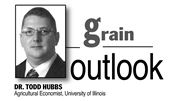Current Corn Price Prospects

December corn futures closed the week ending October 27 at $3.48 per bushel continuing a pattern over the last month of small deviations within a range between $3.45 and $3.55. Additionally, the monthly average price of corn received by U.S. producers has been less than $3.50 per bushel since August of 2016 and has been below $4.00 for 37 consecutive months. An extended rally in corn prices during the next marketing year requires reduced corn supplies, increased consumption, or some combination of both factors.
On the consumption side, feed and residual use of corn is currently projected to increase approximately six percent this marketing year. Additional increases to feed use could occur based on current livestock prices and inventories. At this point, a significant change in the USDA feed and residual use projection seems unlikely. Corn used for ethanol production is forecast to increase by a mere 37 million bushels during this marketing year. An increase might be generated by a continued expansion in gasoline consumption or a continuation of the ethanol export levels witnessed in the 2016/17 marketing year. Ethanol production is up about three percent through October 20 of the 2017-18 marketing year. Corn used for ethanol production in September will be released in the USDA's Grain Crushings and Co-Products Production report on November 1. It seems unlikely that corn used for ethanol production this year would exceed the current USDA projection by more than 100 million bushels.
At 1,850 million bushels, U.S. corn exports are forecast at 443 million bushels lower than exports of a year earlier. The decrease primarily reflects the larger corn harvest in South America during 2017. Export inspections through the first eight weeks of the current marketing year were 45 percent lower than inspections of a year earlier. Current export inspections equal almost eleven percent of the USDA export projection compared to a 5-year average of 13.8 percent. Outstanding sales as of October 19 were approximately eleven percent smaller than outstanding sales of a year earlier. Caution should be used when measuring the export potential for the current year based on the level of export sales relative to the prior year. U.S. exports may begin slowly and end build throughout the marketing year due to the South American production shortfalls or other consumption factors. However, the current pace of exports does not show any sign of exceeding the current projection by a substantial margin.
A price rally for corn in the short run may come from the supply side. The release of the USDA’s Crop Production on November 9 will have an updated forecast of the size of the 2017 corn crop. During the previous 30 years, there were nine years when the average yield forecast increased each month from August through October. The November forecast was below the October forecast in two of those years. The current slow pace of harvest, especially in northern states, is generating mixed expectations about the potential change in the forecast this year. An adjustment in the 2017 production forecast this month is not expected to be large enough to provide a substantial change to the current corn price scenario.
The corn supply for this marketing year will be influenced by global production and the potential size of the South American crops merits special consideration. Brazilian corn production increased approximately 1.2 billion bushels last year to 3.88 billion bushels after recovering from the previous year’s drought. Early season USDA projections are for a production decrease in 2018 to 3.7 billion bushels. Early scouting reports out of Brazil place corn production in 2018 at around 3.5 billion bushels which is significantly lower than current USDA forecasts. Also, Argentina is expected to expand corn production in 2018 by approximately 39 million bushels. It is too early in the growing season to assess yield potential, but production below these early projections may hold potential for stronger U.S. export levels in 2018.
In 2018, a reduction in corn acreage in the U.S would hold the most likely scenario for increased corn prices. However, current projections for 2018 place planted acreage near or slightly above the 2017 level of 90.4 million acres. Corn prices would be expected to get a boost if acreage is reduced enough to result in smaller stocks at the end of the 2018-19 marketing year. Without a reduction in harvested acres, the prospect for lower ending stocks relies on low U.S. yields and a significant increase in consumption.
The prospect of higher corn prices due to a reduction in the estimated size of the 2017 U.S. crop or stronger than projected demand for corn appears unlikely at this time. Therefore, a smaller than expected South American crop or a much smaller U.S. crop in 2018 remain as potential sources for higher prices. In the near term, the continuation of corn price in the current range is likely with a low potential for a break out anytime soon. ∆
DR. TODD HUBBS: Agricultural Economist, University of Illinois